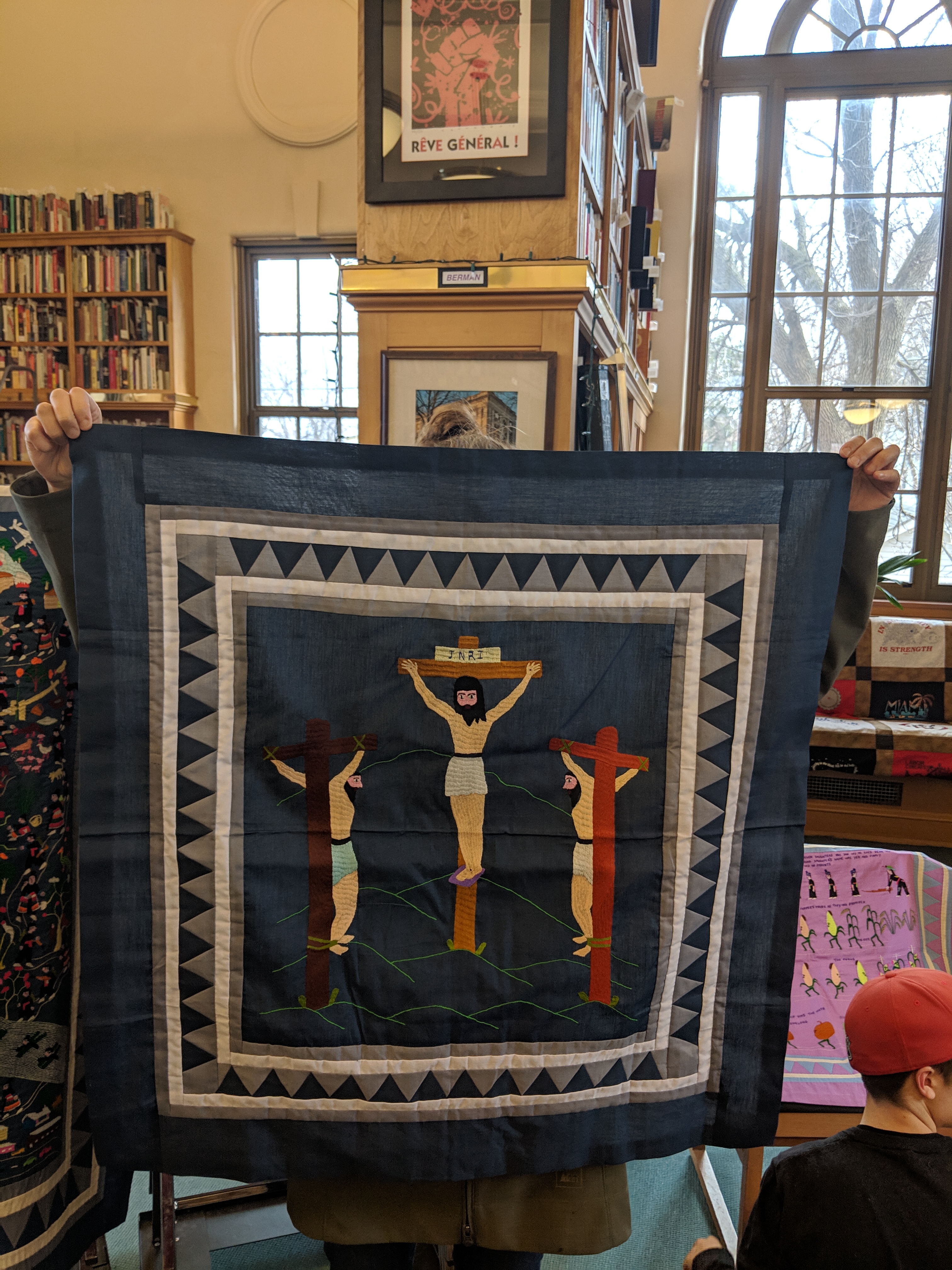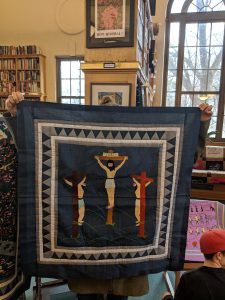Jesus’s crucifixion is an event that has been retold countless times since it happened throughout societies around the world. While we generally associate the stories and cultural significance of Jesus as a Western tradition, this Hmong story cloth forces us to rethink this assumption. Therefore, the story cloth tells highlights two very important aspects of Hmong culture. The first being that the Hmong were Christian and this was is central to their culture, especially if this was included on a story cloth made with the intention of selling. This story cloth also demonstrates the success of Christian missionaries in Southeast Asia, as the Hmong were not Christian until the arrival of missionaries in the early 20thCentury. Christian missionaries first arrived in villages in Southwest China and ultimately spread their influence throughout the region and the Hmong people.
The story cloth, made by hand out of blue shades of cotton and polyester blend, is square and approximately three feet by three feet. It features Jesus hanging on the cross, accompanied by the two other people hung alongside him. The top reads “JNRI,” which means “Jesus, King of the Jews.” According to Marlin, the archivist at the Eastside Freedom Library, it was made in a refugee camp in Thailand in 2012 and was intended to be sold. In 2012, Martin bought it from the Hmong in the refugee camp. The cloth is in extremely good condition, and had no noticeable tears or marks not meant to be there. This is most likely because it was purchased and immediately preserved in the archive.
This cloth is very interesting because, as previously mentioned, it retells a story that has truly been told an unimaginable amount of times throughout world history. While one might “know” the beginning, middle, and end of the story if they are familiar with the story of Jesus, the story on this cloth is frozen in time, only showing Jesus hanging on the cross. Depending on interpretation, we could understand this moment as the beginning, middle, or end of the history or story. To an extent, this is the beauty of the cloth—there is a lot open to interpretation, especially depending on one’s understanding of Jesus. Perhaps this tells us that the maker of the cloth felt this moment in history to be the most important. However, this remains similar to many other narratives of Jesus, which also focus on the moment of crucifixion. The cloth represents Jesus at his least powerful, the moments preceding his death. Thus, the agency in the story might belong to the Romans, who were powerful enough to kill him. Yet, if we interpret this religiously, we would say that God made this happen and God has agency in the story. Furthermore, the creator of the cloth exerts agency, as they chose this exact moment to sew into the fabric.
The story of Jesus is interesting because it is blurs the lines of history and religion, which is similar to other oral histories we learned about. In the Illiad, Sunjata, the Winter Counts, and Beowolf, we see similar occurrences of religion and history coming together, especially in terms of how and why events happen and the causation of them. Here, we infer that the creator of the cloth probably believed that God caused Jesus to be crucified, which is similar to these other oral histories where either God or gods caused events to happen. However, the Hmong story cloths differ from these other forms because they sewed the story into the cloth. Perhaps this is most similar to the Winter Counts, but remains different in the mechanism in which they used to record the history. Furthermore, this history is similar to Beowulf in terms of the causation being God, yet different, because Beowulf exists in written form as opposed to cloth form. By applying the lens of Christianity as the Hmong understood it, we must say that God has agency in the story and God causes events to happen. Therefore, we might say that “God” was the griot, and the maker of the cloth retold this story.
By: Oriana Galasso


You must be logged in to post a comment.